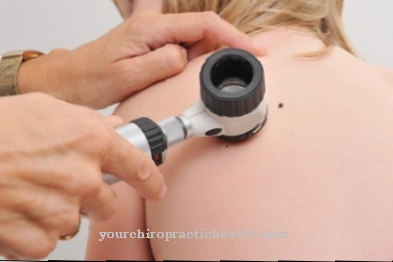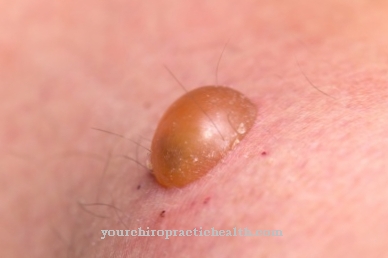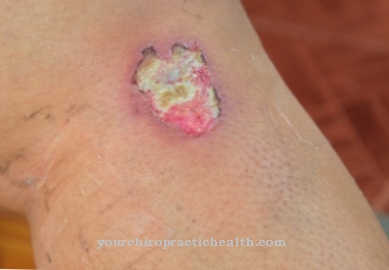From one Extension inhibition of the fingers is the talk when the fingers can no longer be stretched properly. In addition, those affected often feel pain.
What is extension inhibition of the fingers?
.jpg)
Doctors also refer to a stretch inhibition as an extension inhibition. What is meant is a restriction of movement. It shows when a joint can no longer be stretched properly and painlessly - in this case it is the fingers that can no longer be stretched.
A distinction is made between active and passive stretch inhibition. Active extension inhibition is when the affected person can no longer extend the joint with the help of his muscles, but passive extension is feasible. If it is a passive extension inhibition, even the examining doctor can no longer completely straighten the finger joint.
The degree of extension inhibition is felt differently from person to person. In most cases, the inhibition of extension is associated with pain. But it can also be pain-free. The patient is unable to move the affected finger from a flexed position. A change of position can only be achieved through external help.
causes
In most patients, there are two causes of inhibition of extension in the fingers. The first cause is the so-called snap finger, which is also known as flexor tendonitis or trigger finger. Inflammation in the tendon sheath is responsible for inhibiting the extension of the affected fingers. The inflammation occurs in the thumb or in the cupped hand. It is noticeable through pain when the person concerned tries to stretch their finger.
The cause of the inhibition of extension is a thickening of the tendon and flexor sheaths. Under the fingers, the flexor tendon merges into the tendon sheath within the palm of the hand. If there is inflammation at the transition point between the tendon sheath and flexor tendons, this results in a narrowing of the entry point. If the flexor tendon thickens, there is no longer enough space for the tendon sheath, causing it to become trapped. This in turn leads to a blockage in the stretching process.
Dupuytren's disease is the second cause of the inhibition of stretching. This is a benign disease of the connective tissue on the inner surface of the hand. It is also called Dupuytren's contracture and belongs to the group of fibromatoses. The little finger and ring finger are particularly affected by Dupuytren's disease. In principle, however, the disease can show itself on any finger.
This leads to knot-like hardening of the connective tissue. These are responsible for inhibiting the extension of the affected fingers. This creates an unnatural flexion of the finger, in which the inner surface of the hand is approached. The affected finger cannot be stretched, nor does it have sufficient strength.
Diseases with this symptom
- Flicking finger
- gout
- Dupuytren's disease
- arthrosis
- Tendinitis
- rheumatism
Diagnosis & course
A stretch inhibition can usually be diagnosed by a physical examination by the attending physician. The typical symptoms are clearly recognizable. Sometimes, however, magnetic resonance imaging (MRI) may be required to get a clearer picture of the tendon and flexor sheaths. Dupuytren's disease is mostly recognized by a sudden snap of the diseased finger. However, this requires a certain degree of stretching or bending.
As part of a palpation examination, the doctor determines nodal changes that are associated with Dupuytren's disease. The different stages of the disease also play an important role in the examination. So there are a total of five stages. In stage 1, Dupuytren's disease is barely recognizable because the patient still has complete freedom of movement. However, nodes can already be felt at this stage.
In the further stages, the extension inhibition is divided into degrees of severity. A classification from 1 to 5 degrees is made in stage 1 to 135 degrees in the last stage of the disease. This is the expression of the deviation from the normal dimension. In addition, in the further course of Dupuytren's disease, skin wrinkles form due to the flexion of the fingers.
If the diagnosis of extension inhibition on the fingers is made in good time and appropriate therapy takes place, the pain can be effectively relieved. In addition, the patient can move his fingers better again.
Complications
Complications from an inhibited extension of the fingers with and without treatment are not uncommon. A physical examination at the family doctor's is enough to choose the right treatment, since the symptoms are clear when the fingers are inhibited. The affected patients experience this inhibition very often as a great shock, since they can no longer move their fingers as usual.
No further complications are to be expected if the fingers are inhibited. Rarely does it happen that the inhibition is low at the beginning and then worsens. This is an exceptional case. With a snap finger you have to choose between an operative and a non-operative method.
During an operation, the doctor must educate the patient about possible complications that could arise during the operations. If the patient's inhibition is not so strong, the doctor dispenses with an operation, as this also reduces the chances of many complications. Daily massages and certain cortisone-containing preparations are used.
Only experts should perform the massages here. The chance of dislocating something with an anti-stretch is still far too great. Nowadays, not many complications are known about these treatment methods in practice, although they exist in theory.
When should you go to the doctor?
As a rule, a doctor should be consulted in any case if the fingers are inhibited. This symptom can be a serious illness or injury that definitely requires medical attention and in most cases will not go away on its own. An emergency doctor should be called if the fingers were inhibited from stretching immediately after an accident or if the symptom is associated with severe pain. In addition, the patient should not take pain medication for a long period of time.
If the person concerned is not sure about the causes of the inhibition of extension of the fingers, the hospital or a general practitioner can primarily be visited. If you have precise knowledge, you can also go directly to the specialist for treatment. Treatment solely with self-help means is not recommended if the fingers are inhibited from stretching. In most cases, the symptom can be treated well.
Doctors & therapists in your area
Treatment & Therapy
The treatment of extension inhibition on the fingers can be carried out in both a conservative and an operative manner. If an operation is not necessary, the affected fingers are consistently relieved. The patient is not allowed to do any manual work or work with shovels.
Since the extension inhibition causes water to accumulate within the flexor tendon sheaths, massages are performed every day that reach from the fingertips to the palm of the hand. It is also useful to stretch the affected finger with another finger.
In order to fight the inflammation, the patient is given preparations that have an anti-inflammatory effect. If these do not work well enough, there is the option of injecting cortisone near the flexor tendon sheath. These treatment measures are effective in around 60 to 70 percent of all those affected.
If an operation has to be performed, the surgeon expands the flexor tendon sheath with an incision. Surgical intervention usually takes place when the patient has been suffering from the symptoms for months and conservative therapy is unsuccessful. If Dupuytren's disease is present, the surgeon removes the connective tissue nodes or reduces them with radiation.
Outlook & forecast
The stretch inhibition of the fingers results in extremely severe restrictions for the patient in everyday life. As a rule, ordinary activities can no longer be carried out or are associated with extremely severe pain. The patient's quality of life is reduced by the inhibition of extension of the fingers.
The further course and treatment of the disease depend heavily on the cause. If the stretch inhibition occurs mainly after physical or strenuous work, this work must be restricted. Most of the time the symptoms go away, even without medical treatment. In some cases, surgery or massages are necessary to relieve symptoms.
Medicines are also used, which may prevent or combat inflammation. This can avoid further complications and complaints. Medicines containing cortisone are also used. The treatment may have to be repeated after a certain period of time if the symptoms recur. Even after the treatment, the patient should avoid excessive strain and exertion.
Life expectancy is not influenced by the stretch inhibition of the fingers. Should there be psychological complaints due to the restrictions, these can be treated by a psychologist.
prevention
The best preventive measure against stretch inhibition is to avoid excessive finger pressure. It is much more difficult, however, to prevent Dupuytren's disease. The exact causes of the disease are still unknown.
You can do that yourself
In everyday life, the stretch inhibition of the fingers is not necessarily perceived as limiting. It should be noted here that there are courses with or without pain. Grasping, touching and feeling can also be successful with a slightly angled misalignment of individual fingers. Therefore, the person affected should not allow themselves to be inhibited in any way in their movements. On the contrary, behavior to protect the hand only increases the quality of life, but does not effectively bring healing or relief.
What can be advised for self-help are regular hand massages and ergotherapy measures. It is advisable to do finger gymnastics, gripping exercises and shaking hands lightly. During the exercises, however, strict care should be taken not to exceed pain limits. Kneipp baths for the arms and hands can also bring about improvement.
Only as the disease progresses is it likely that the hand will not function properly. The sick person notices this at the latest when objects can no longer be properly grasped. Then, of course, if pain occurs as an accompanying symptom, professional help should be sought immediately. The family doctor can initiate quick treatment measures.



























